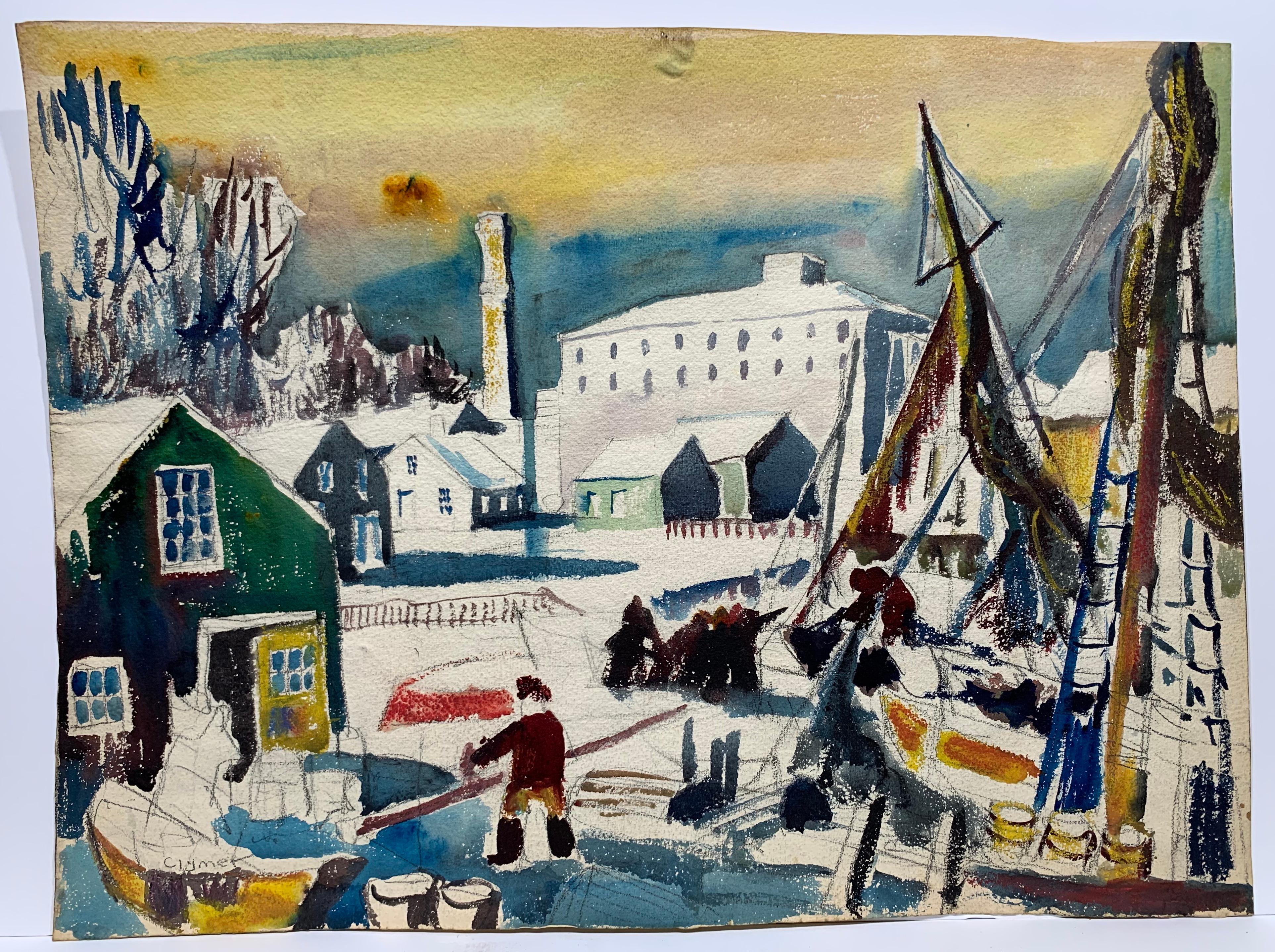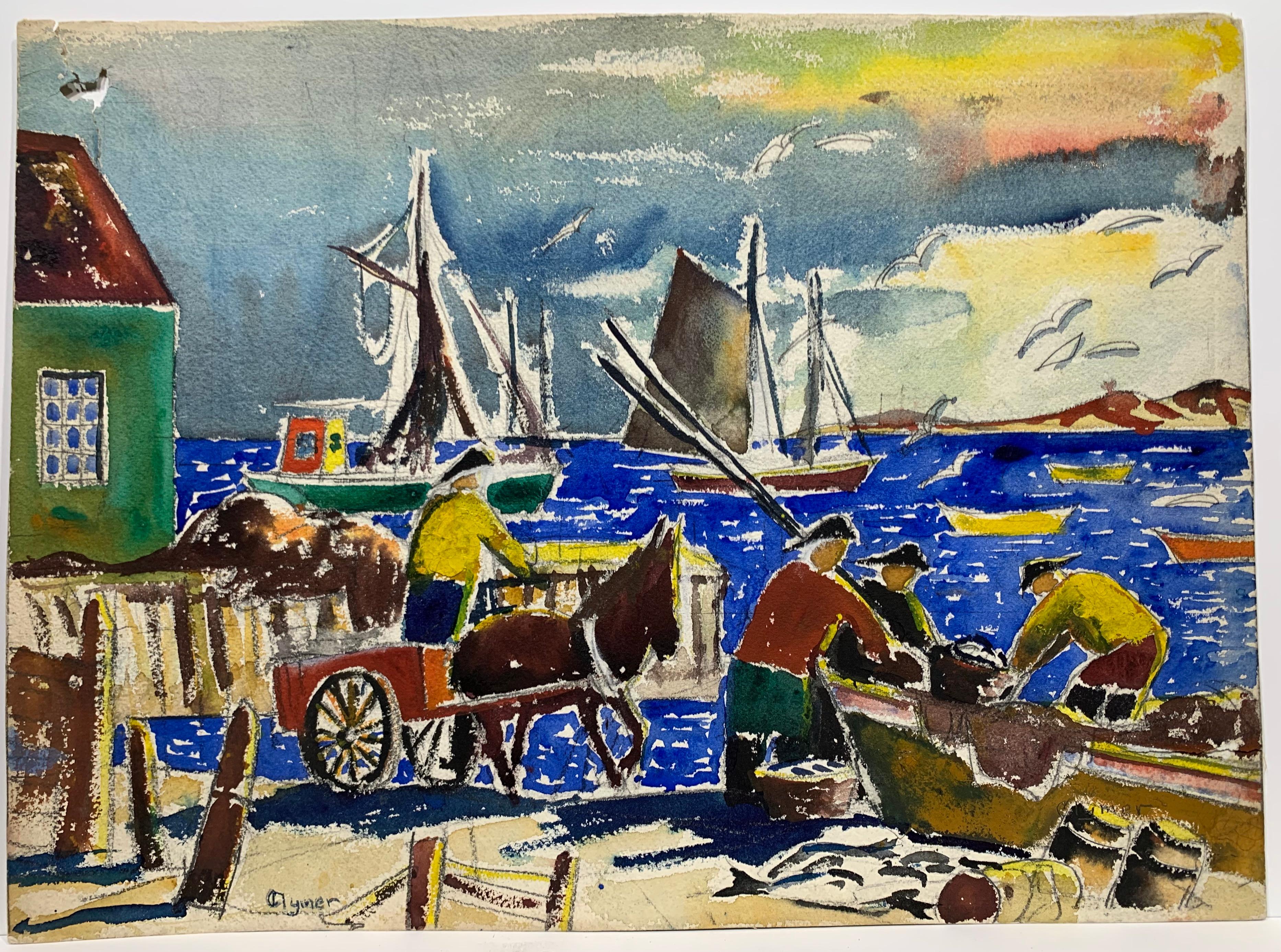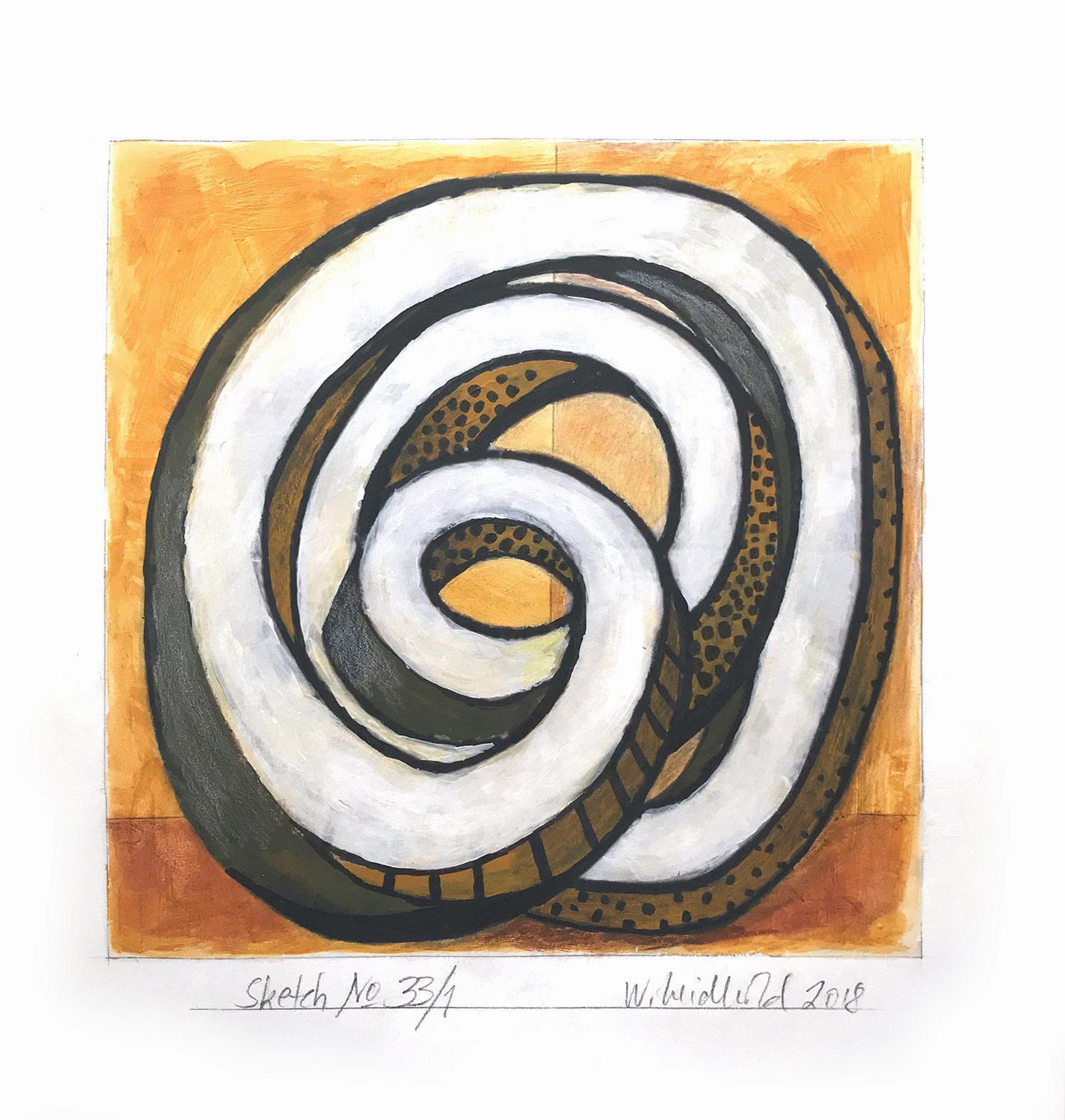James Floyd ClymerProvincetown (Cape Cod landscape)ca. 1930
ca. 1930
About the Item
- Creator:James Floyd Clymer (American)
- Creation Year:ca. 1930
- Dimensions:Height: 15 in (38.1 cm)Width: 20.5 in (52.07 cm)
- Medium:
- Movement & Style:
- Period:
- Condition:
- Gallery Location:Wilton Manors, FL
- Reference Number:1stDibs: LU24528678422
James Floyd Clymer
James Floyd Clymer known for his regionalist style of land, sea and cityscapes, created paintings with an emphasis on color and form. His works possess a clear and simple style, easily understood by the masses. Born in Perkasie Pennsylvania, 20 miles north of Philadelphia, Clymer was the youngest of seven children. Losing his mother during childbirth, he was raised by his eldest sister. He attended Drexel University in Philadelphia, studying Art and Architecture and worked as an Architect in the years following World War I. During this time, Clymer met the artist Gwenyth Waugh, daughter of the renowned marine painter, Frederick Judd Waugh. Clymer thrust then changed from Architect to Artist. Together, the couple traveled to destinations such as Spain and Newfoundland, where they gave birth to their only daughter. In the early 1920s, Clymer and family settled in Provincetown, Massachusetts and quickly became associated with notable artists such as Helen Sawyer, Edwin Dickinson and the Waughs. About 1940, Clymer moved to New York City, and in 1946, he and his family settled in a home on Schunnemunk Mountain in New York (close to Newburgh, New York, in the Hudson River Valley). He lived there until circa 1978 when he moved to his granddaughter's house near Schenectady, New York, where he later died. Clymer worked with ease in the mediums of watercolor and oil painting, much like James Fitzgerald and Marsden Hartley. Parallels exist in the work of the three artists, such as their affinity to the New England coast for their subject matter. Further, these artists pursued highly personal styles, making it difficult to link them to anyone's art movement. All three artists were adept at blending naturalism and abstraction while maintaining a respect for and a keen observation of nature. Clymer tended to depict permanence and impermanence in nature, painting simple, colorful forms to create vistas in sea and sky or mass in mountains and buildings. He then would present figures in motion, such as humans, birds and boats to complete his artistic theme. Like Hartley and Fitzgerald, Clymer's economy of detail states so much with so little, allowing the work to possess a powerful and expressive quality. Clymer was a member of the Provincetown Beachcombers Club, a select group devoted to the arts, as well as a member of the Provincetown Art Association, where he exhibited 65 works between 1922–40. His works were also featured in exhibits at the Pennsylvania Academy of Fine Arts, the Art Institute of Chicago, the Corcoran Gallery and various galleries in NYC during the 20s, 30s and 40s. Clymer is listed in Who Was Who in American Art.
- ShippingRetrieving quote...Ships From: Wilton Manors, FL
- Return PolicyA return for this item may be initiated within 7 days of delivery.
- Provincetown (Cape Cod landscape)By James Floyd ClymerLocated in Wilton Manors, FLBeautiful abstract painting by American artist, James Floyd Clymer (1893-1982). At the Weir Trap, ca. 1930. Watercolor and pencil on paper measures 15 x 20 inches. Signed lower margi...Category
Early 20th Century Abstract Abstract Paintings
MaterialsWatercolor, Rag Paper, Pencil
- Provincetown (Cape Cod landscape)By James Floyd ClymerLocated in Wilton Manors, FLBeautiful double-sided abstract painting by American artist, James Floyd Clymer (1893-1982). Docks in Winter, ca.1930. Watercolor and pencil on paper measures 15.25 x 20.5 inches. Si...Category
Early 20th Century Abstract Abstract Paintings
MaterialsWatercolor, Rag Paper, Pencil
- Provincetown (Cape Cod landscape)By James Floyd ClymerLocated in Wilton Manors, FLBeautiful abstract painting by American artist, James Floyd Clymer (1893-1982). Docks, Sunrise, ca.1930. Watercolor and pencil on paper measures 16 x 21 inches. Signed lower margin. ...Category
Early 20th Century Abstract Paintings
MaterialsWatercolor, Rag Paper, Pencil
- Coronel Retirado y Su Amante Esposa (Cuban Artist)By Felipe OrlandoLocated in Wilton Manors, FLFelipe Orlando (Cuban-Mexican, 1911-2001). Coronel Retirado y su Amante Esposa, ca. 1970. Ink and gouache on paper with heavily built up layers of textured ground. Measures 13 1/4 x 18 3/8 inches. Signed lower left. Original label affixed on verso. Excellent condition. Unframed. An anthropologist as well as a painter and engraver, Orlando, whose full name was Felipe Orlando Garcia Murciano, studied at the University of Havana and at the painting workshop of Jorge Arche and Víctor Manuel. He was a founding member of the Asociación de Pintores y Escultores de Cuba (APEC) and a professor at the Universidad de las Américas and the Universidad Nacional Autónoma de México, both in Mexico City. His style is influenced by the Afro-Cuban movement and pre-columbian art...Category
1970s Abstract Abstract Paintings
MaterialsInk, Gouache
- Mother and ChildBy Bruno LucchesiLocated in Wilton Manors, FLBruno Lucchesi (b.1926). Mother and Child, ca. 1960. Oil and charcoal on sized paper mounted to masonite, measuring 11 x 21 inches; 15.5 x 25.5 inches in original gold leaf frame. Si...Category
Mid-20th Century Abstract Figurative Paintings
MaterialsMasonite, Oil, Paper
- Fisherman at DuskBy Oskar D'AmicoLocated in Wilton Manors, FLOskar D'Amico (1923-2003). Fisherman at Dusk, c.1960. Oil on linen canvas, 16 x 30 inches; 18 x 32 inches (frame). Signed lower right. Excellent condition with no damage or conservation. Biography: Oskar Maria D'Amico (February 22, 1923 – May 3, 2003) was an active Italian artist in Rome, Naples, Lanciano, Cisterna, Milan, Gallarate, Torino, Zagabria, Paris, Toulouse, Melun, Carenac, Maubeuge, Madrid, Barcelona, Zaragoza, Budapest, Győr, Mexico City, Cuernavaca, Morelia, Toronto, New York City, Philadelphia, Los Angeles, San Francisco, Miami, Denver, Santa Fe, Albuquerque and Socorro, between 1943 and 2003. He is considered a Nomad artist because of his ability to work in various styles. He had three major periods in his artistic life: Figurative, Materic and Geometric. [1]He also was an outstanding art director for more than 75 epic movies. D'Amico had a very outgoing personality. He was a non-conformist, which was reflected in his work throughout his life. D'Amico was born in CastelFrentano, Italy, a small village in Abruzzo. At a young age, he felt he had to leave and dive into the big world. After being a seminarist with the Salesiani during World War II, he left Naples, where he studied architecture, and began a great adventure in Rome. He specialized at the time in decorating nightclubs and bars, and invented a special type of double ceiling to hide the lights. D'Amico, who was self-taught as a teenager in drawing and painting, burst onto the filmmaking scene in Rome when an art director asked him to do a perspective of a set design. Soon other moviemakers were calling him.[2] D'Amico was an art director on 75 films including two by Orson Welles. D’Amico was able to create a real marble floor in the set of the palace of the King Saul, in "David and Goliath" directed by Orson Welles. Art directors previously painted a simulated marble on top of concrete due to the cost of the real thing. D'Amico became an associate of Jadran Films in ex-Yugoslavia, which specialized in Roman and Egyptian constructions. While an art director, he never stopped painting. His faceless clowns, reflecting the people who had no identity after World War II, were a big success. In the early 1960s, D'Amico moved with his family to Toronto, Canada, another place he felt was too small. He left for Philadelphia and New York City, which affected his work. He turned his focus to abstract, and for more than a decade created abstract Expressionist paintings "on the plane of all matter" that he called "Materic". The Materic style, which he invented, was done in several media and could not be changed once on the canvas. The paintings were very well received. D’Amico sold more than 400 in Philadelphia and New York City. Unfortunately he had to stop doing the Materics because the colors he used were harmful to his liver. In the mid 1970s, he returned to his architectural roots and developed a new vision for Abstract Constructivism using just acrylic colors. Presented in Paris by his French Art dealer, Francoise Tournier, at the Grand Palais de Paris, and in Mexico City, D'Amico's interpretation of the "New Geometry" was widely admired. In 1983, when he presented the work at the Bodley Gallery, people whispered that he had the potential to be the new Picasso because of his eclecticism and the Nomad nature of his styles. In 1987, D'Amico abandoned the gypsy life and settled in New Mexico. Albuquerque was the perfect place to dedicate himself 100 percent to his work.[3] There were no distractions and a good climate that reminded him of his beloved Cuernavaca in Mexico. Staying in close contact with his French art dealer Tournier, D’Amico had several shows in Denver at the Helen Karsh Gallery and in Albuquerque at the Black Swan and Café Galleries. At least once a year, D’Amico went to Europe to immerse himself in the antique world and visit museums and galleries. In 1992, visiting Tournier at the Castle of Saint Cirq Lapopie, he met the man who founded the MADI movement in 1940, Carmelo Arden Quin...Category
1960s Abstract Figurative Paintings
MaterialsCanvas, Oil
- "Kinetic Knot No. 2/5" Abstract Representational Knot Painting Work on PaperBy Wolfgang LeidholdLocated in New York, NYThis piece represents a part of the artist's "Kinetic Knots" series which symbolizes shapes of the knots that are not planned. It is like the “Dao” grabbing the artist and the power ...Category
2010s Abstract Geometric Abstract Paintings
MaterialsPaper, Ink, Acrylic, Pen, Watercolor, Pencil
- "Sketch No. 33/1" Abstract Representational Kinetic Knot Painting Work on PaperBy Wolfgang LeidholdLocated in New York, NYThis piece represents a part of the artist's "Kinetic Knots" series which symbolizes shapes of the knots that are not planned. It is like the “Dao” grabbing the artist and the power ...Category
2010s Abstract Geometric Abstract Paintings
MaterialsInk, Acrylic, Watercolor, Pen, Paper, Pencil
- From Tree to SeaBy Darius YektaiLocated in Sag Harbor, NYAbstract figure swinging on a tree branch in foreground. Seascape, coastline background. Thick, textural brush strokes. Darius's most recent body of work is bright, colorful, wi...Category
21st Century and Contemporary Abstract Abstract Paintings
MaterialsOil, Linen, Watercolor, Paper, Charcoal, Graphite
- "Relaxing at Camarillo" - Abstract ExpressionismLocated in Soquel, CA"Relaxing at Camarillo" - Abstract Expressionism A man relines in a black hat and a green shape emulating the symbol of infinity, accented in bright canary yellow and gray, by Calif...Category
21st Century and Contemporary Abstract Expressionist Abstract Paintings
MaterialsPencil, Paper, Acrylic, Gouache
- Two Figures - Abstract Impressionist Composition in Acrylic Arches PaperLocated in Soquel, CAThe Monuments - Abstract Impressionist Composition in Acrylic on Laid Paper A bold abstract painting by California-based artist, Ricardo de Silva (Br...Category
1980s Abstract Impressionist Abstract Paintings
MaterialsAcrylic, Cotton, Rag Paper
- Boxing Scene. Vanquished Boxer in his Corner. Sports Illustrated Boxing StoryBy Bob PeakLocated in Miami, FLThere are a lot of people in the art world today who dismiss illustrators are being commercial solely because the artists identified as being commercial artists and that the work was done on assignment. Sadly these art world people have limited imagination and a restricted sense of curiosity. This boxing illustration/painting was done for Sports Illustrated...Category
1960s Abstract Expressionist Figurative Paintings
MaterialsWatercolor, Gouache, Pencil






